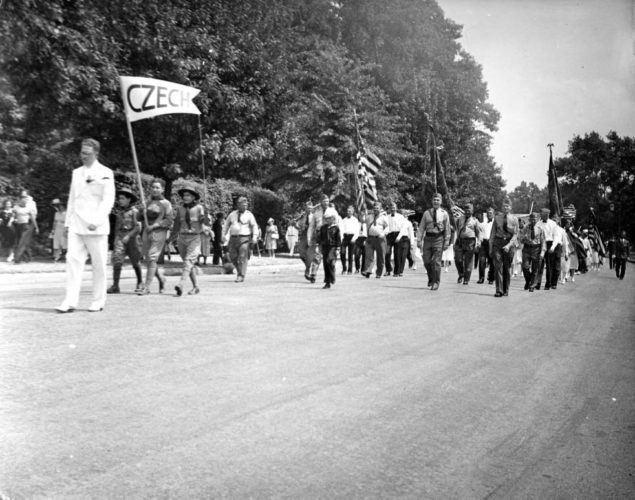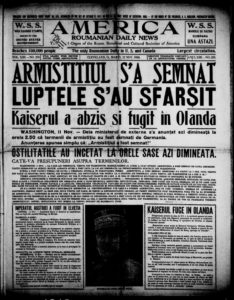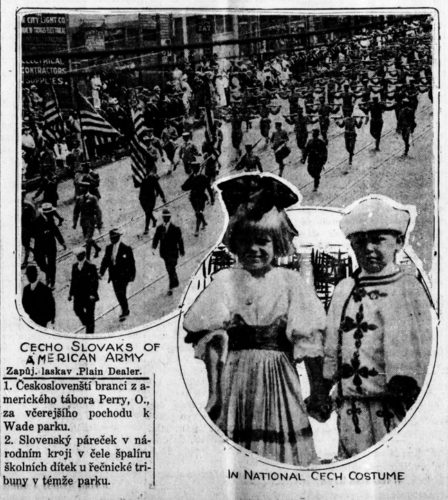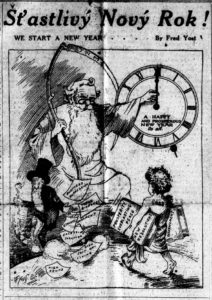More News about Newspapers

Over the past two years, the Ohio History Connection has digitized and added over 100,000 pages of foreign language newspaper content to Chronicling America, where they are freely available and keyword searchable in their original language. Researchers now have access to hundreds of unique stories documenting several immigrant groups that settled in Ohio and beyond during the late-19th through mid-20th centuries, seeking better economic opportunities, religious freedom and/or political asylum. Many ended up in in urban centers where low-paying industrial jobs were plentiful, and several immigrant neighborhoods had already been established. We have previously highlighted Croatian, German, Hungarian German, Lithuanian, Polish and Slovenian newspapers, and today we’re pleased to feature the most recent additions to Chronicling America:
- Cleveland America, 1918-1922 (Romanian)
- Cleveland Pokrok, 1874-1876 (Czech)
- Cleveland SveÌŒt, 1918-1924 (Czech)
- Youngstownske’ Slovenske’ Noviny, 1920-1936 (Slovak)
Our final title for this phase of our project, Youngstown Amerikai Magyar Hirlap, 1920-1942 (Hungarian), will be added soon. (Click here to see a full list of Ohio’s foreign language newspapers on Chronicling America.)

Romanians numbered nearly 20,000 in Cleveland around 1914; to serve this growing population, the America newspaper was established in 1905. It would eventually become the largest Romanian newspaper in the country, with 10,500 subscribers during World War I, and over 17,000 subscribers in 1922. As the official organ of the Union of Roumanian Beneficial Societies of America, the paper aimed to disseminate Romanian culture alongside international, national and state news, focusing on the needs of the working class. Its contents included political news and events; information about aid societies; opinion columns and editorials; literary excerpts; historical information; and personal columns and want ads. It absorbed its rival publication, Românul (“Roumanian”), in 1928 and appears to have ceased publication around 2009.
Cleveland was the fourth largest Czech city in the world by 1919 and an important center of Czech progressivism and socialism. During this time, Czechs typically identified themselves with one of three groups–freethinkers, socialists, and religious–and Cleveland’s Czech-language newspapers reflected all three of these ideological divisions. Pokrok (“Progress”), established in 1867 in Chicago and moved to Cleveland in 1871, and SveÌŒt (“World”), established in 1911, represented the anticlerical, freethinker segment. Both papers reported on local, state, national, and international news; politics; and local business information and community events. For a time, Pokrok was the best way to reach Czechs across the nation. SveÌŒt absorbed Pokrok in 1915, by then known as Dennice NovovÄ›ku (“Star of the New Era”), and remained in publication until 1986.

Slovaks in Youngstown and the surrounding areas in the Mahoning and Shenago Valleys were served by Youngstownske’ Slovenske’ Noviny. By 1920, the Slovak population in Ohio had reached over 42,000, and this publication provided them with local, national, and international news. Much of the latter related to Czechoslovakia and other Eastern European countries. Articles covered topics as wide ranging as politics, citizenship, sports, crime, concerts, social and religious calendars, and sometimes included excerpts from novels. Other immigrant communities in the area were represented by the Noviny as well.

Between 1900 and 1920, the number of Hungarians living in Ohio grew from 15,000 to over 73,000. The Amerikai Magyar Hirlap (“American Magyar Journal”) began in 1911 in Youngstown, Ohio, to promote Hungarian interests across the Mahoning and Shenango Valleys of northeastern Ohio and western Pennsylvania. Like its contemporary immigrant newspapers, it printed a variety of content, including: reports from Europe, especially covering Hungarian news and politics; health information and tips; novel excerpts; church notices; local events; business advertisements; and general political news. The Hirlap also reported on the American Hungarian Federation, a benefit society founded in Cleveland in 1906. It ceased publication in 1942 due to financial difficulties and was absorbed by Cleveland’s Szabadság (“Liberty”), the largest and oldest Hungarian newspaper published in the United States.
Explore the history of these and other immigrant communities in their own words through newspapers digitized for Chronicling America and numerous hard copy and microfilm editions of newspapers held by cultural heritage institutions across the country. To learn more about foreign language newspapers, including tips on translating content into English, check out our “Researching with Foreign Language Newspapers,” “Working with German Fraktur” and “Using Online Translation Tools” YouTube videos.
Thanks to Jenni Salamon, Unit Manager, Digitization, for this week’s post!
Chronicling America is the collaborative project of the National Endowment for the Humanities, Library of Congress and state partners, like the Ohio History Connection, to preserve and provide increased access to America’s historic newspapers through the National Digital Newspaper Program. By the end of 2018, the Ohio History Connection will have contributed over 400,000 pages of Ohio’s historic newspapers, including over 100,000 of foreign language content. For more information, visit the National Digital Newspaper Program in Ohio Project Website.



Leave a Reply
You must be logged in to post a comment.